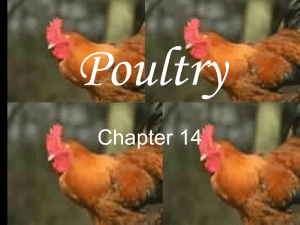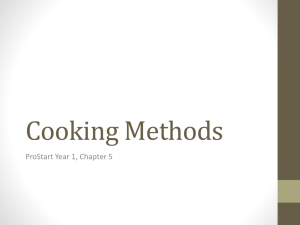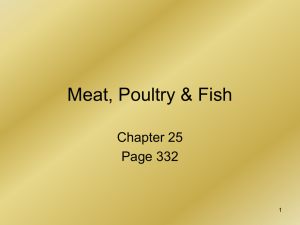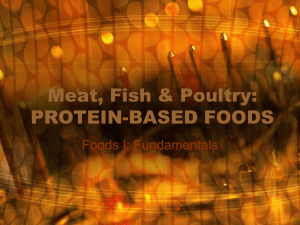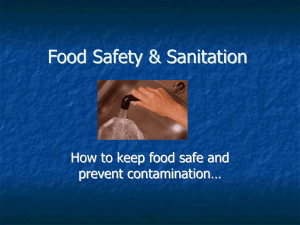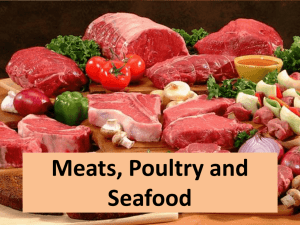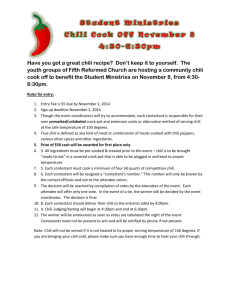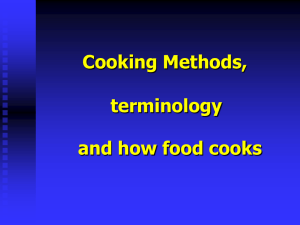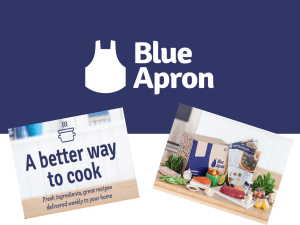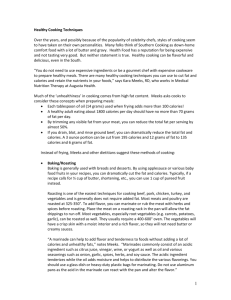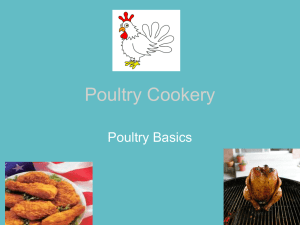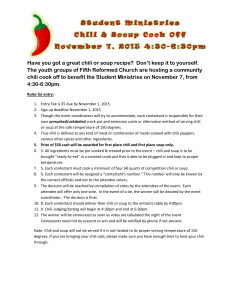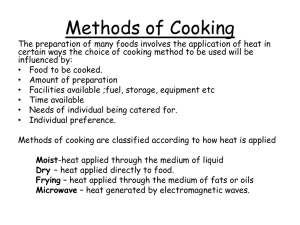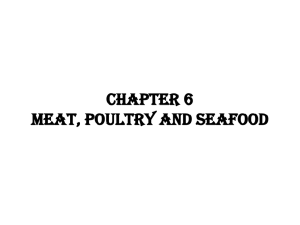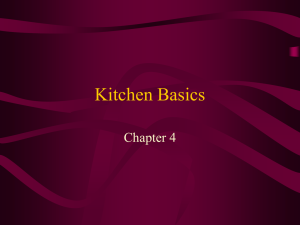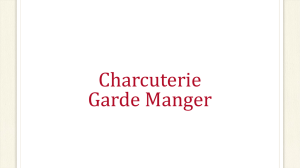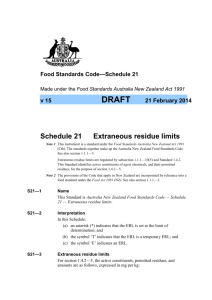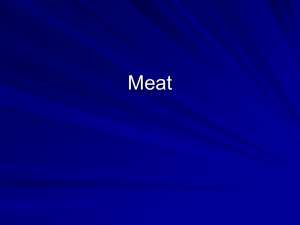ProStart Year 2 Chapter 8 Meat, Seafood and Poultry
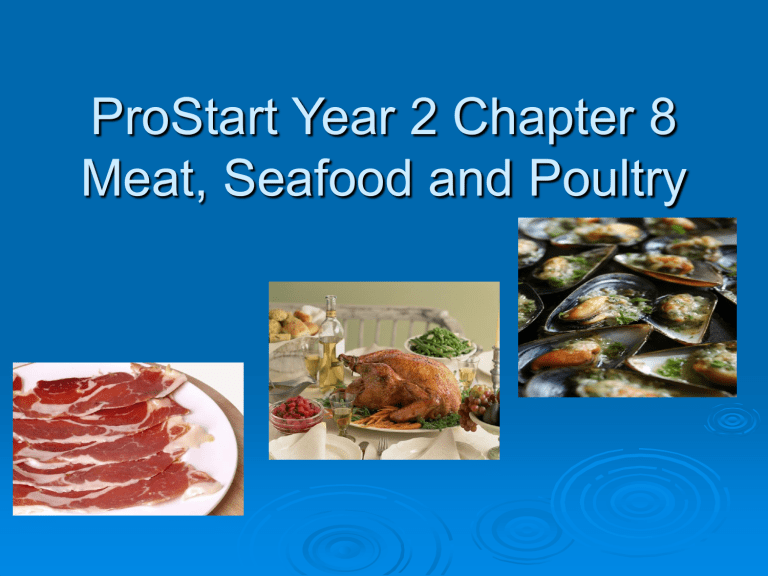
ProStart Year 2 Chapter 8
Meat, Seafood and Poultry
QUALITY GRADES FOR MEAT
Beef Grades Veal Grades Lamb Grades
-Prime
-Choice
-Select
-Standard
-Commercial
-Utility
-Cutter
-Canner
-Prime
-Choice
-Utility
-Standard
-Prime
-Choice
-Good
-Utility
-Deer
-Wild Boar
-Moose
-Elk
-Caribou
-Bear
GAME MEATS
QUALITY GRADES FOR
POULTRY
-USDA A
-USDA B
-USDA C
FACTORS THAT DETERMINE ITS GRADE ARE:
-Shape of the carcass
-Ratio of meat to bone
-Amount of feathers, hair, and down
-Number (if any) of cuts or broken bones
SANITATION FOR POULTRY
FABRICATION
-Refrigerate poultry when it is not being fabricated.
-Never store uncooked poultry above cooked meats.
-Clean and sanitize the cutting board and all cutting utensils before and after fabrication.
-Store poultry in clean, leak-proof containers.
SIGNS OF FRESH FISH
Fresh, clean, “sea” aroma
-Slick, moist skin
-Moist, fresh, flexible with full tail and fins
-Firm and elastic flesh
-Clear and full eyes; gills should have a red or maroon color
-Live crab and lobster should move about; clams, mussels, and oysters should be tightly closed
TYPES OF SEAFOOD
FISH:
-Round (Salmon, tuna)
-Flat (Flounder, sole)
SHELLFISH:
-Mollusks (Clams, oysters)
-Crustaceans (Lobster, shrimp
WHAT IS MEAT?
-Muscle tissue is made up of 75% water, 20% protein, and 5% fat
-Muscle fibers are bound together in bundles
-Bundles are surrounded by connective tissue
-Two types of connective tissue
*Collagen-Breaks down during long, slow, moist-heat cooking
*Elastin-Will not break down during cooking; needs to be trimmed by hand
(silverskin- the thin, pearlescent membrane found on certain cuts of meat, such as tenderloin, is very tough and must be removed in order to prevent the meat from curling during cooking.) answers.com
-Amount of connective tissue increases:
*as the animal ages
*the more the animal exercises
-Marbling is the fat built up between muscle fibers
*Makes cooked meats Juicy
*More marbling in tender cuts (tenderloin, sirloin)
*Tender cuts come from muscles that receive little exercise
Techniques for Adding Moisture,
Tenderness, and Additional Flavor
-Long, slow, moist-heat cooking for tough cuts
*Long, slow cooking breaks down collagen
*Cooking liquid adds moisture
-Marinade: Liquid of oil, herbs, spices, and acid (wine, vinegar)
*adds flavor
*gives attractive exterior look
-Barding: tying a layer of fat to meat before
Cooking
*done to poultry and meat that have little natural fat cover
*fat adds moisture and protects meat during roasting
Overview of Cooking Methods
Dry-Heat Methods
Bake- Cook food in a oven without liquid at temperatures between 250 F and 475 F (121.1 C and 246.1 C)
Broil- Cook food by placing it below a radiant heat source
Deep-fry- Cook food by immersing it completely in hot fat or oil
Grill- Cook food on a rack above heat source
Pan-Fry- Cook food in hot fat or oil over medium heat
Roast- cook food using indirect heat in a closed environment
Sauté- Cook food quickly in little fat or oil over high heat
Moist-Heat Methods
*Boil- Cook food submerged in liquid that has reached the boiling point 212 F (100 C)
*Blanch- Parcook food in boiling water for a very short time.
*Simmer- Cook food completely submerged in liquid at low temperatures (185 F to 205 F, or 85
C to 96.1 C)
*Steam- Cook food in boiling-hot water vapor
Combination Methods
Braise- Sear food in hot oil, then cook tightly covered in a small amount of liquid; finish in an oven or on the stovetop.
Stew- Sear bite-sized pieces of food, then cover them in a liquid and simmer in a covered pot
How to Pair a Fish with a Cooking
Technique
Oily fish
-Dry-heat techniques, such as grilling or broiling
Fish with a moderate amount of fat
-Any cooking Method
Lean fish and Flounder
Poaching or Sautéing
Types of Sausages
Fresh sausages: Made with raw ingredients
-Breakfast sausage links
-Polish kielbasa
-Mexican chorizo
-French andouille
Smoked or cooked sausages: Made with raw meats treated with preservatives
-German Knackwurst
-Frankfurter
-Bratwurst
Dried or hard sausages: Made with cured meats that are air-dried
-Italian salami
-Pepperoni
Types of Forcemeats
Forcemeat: A mixture of lean, ground meat and fat that is forced to combine in a food grinder and is then pushed through a sieve to make a very smooth paste
* Straight forcemeat:
-finely ground, seasoned, and cooked in a terrine
* Country-Style
-main ingredient is cured meat
-slightly coarser than straight forcemeat
-also called pate de campagne
* Mousseline
-delicately flavored
-made with poultry, veal, or fish
-lightened with cream and egg whites
